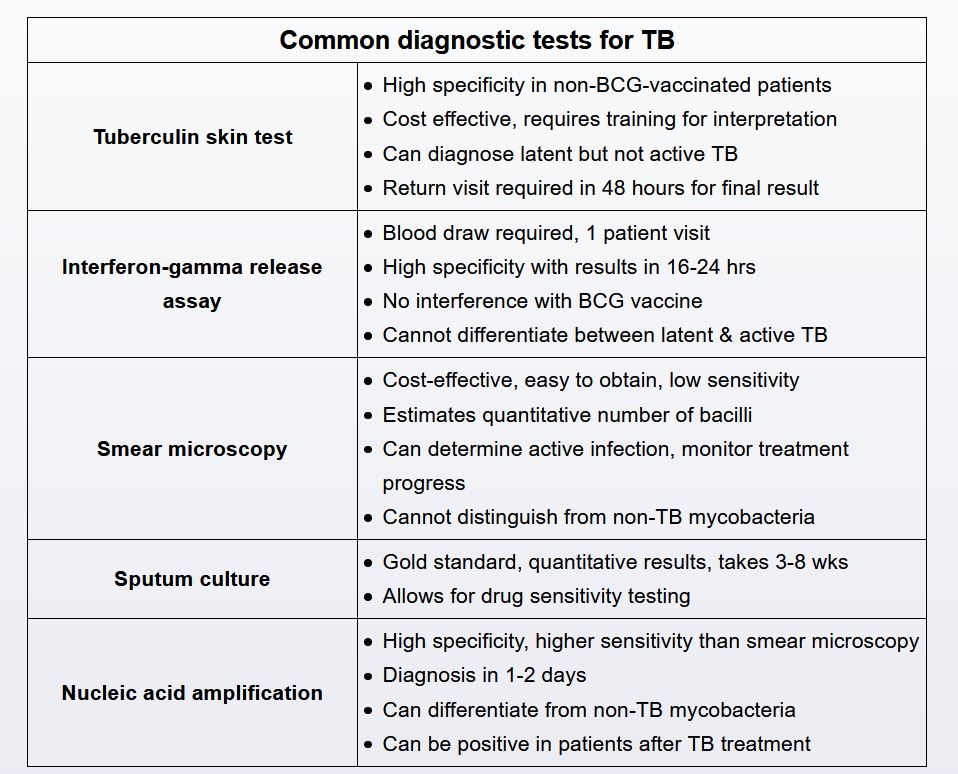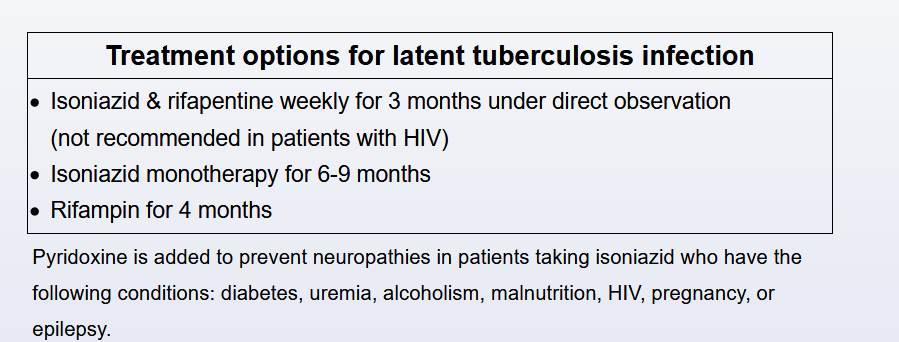Tuberculosis
- related: ID, TB note 11 4, MAC, mycobacterium kansasii, rapid growsers, marinum, gordonae

This patient's clinical presentation is consistent with active pulmonary tuberculosis (TB), which is typically due to the reactivation of latent disease. Suspicion should be raised when individuals with epidemiologic risk factors for exposure (eg, substance abuse, homelessness, birth in a TB-endemic region) develop characteristic clinical manifestations (eg, fever, cough >2 weeks, weight loss).
Diagnostic evaluation begins with chest x-ray to determine if there are signs of active disease such as upper lobe cavitation (70%-80%), hilar lymphadenopathy, or pleural effusion. Patients with suspicious x-ray findings are definitively diagnosed when Mycobacterium tuberculosis is isolated in body fluid or tissue (lung, pleura).
Sputum sampling provides the least invasive and costly route for microbial confirmation. Three single sputum samples (spontaneous or induced) are submitted in 8- to 24-hour intervals with at least 1 early-morning sample. Sputum should be sent for acid-fast bacillus smear, mycobacterial culture, and nucleic acid amplification testing.
Although patients with suspected pulmonary TB should also undergo tuberculin skin testing or interferon-gamma release assay, these tests cannot distinguish between active and latent disease and are ordered primarily to support the diagnosis (positive test results suggest exposure)
Sputum acid-fast bacillus (AFB) smear is the most rapid, least expensive, and widely used diagnostic test for pulmonary tuberculosis (TB). However, this test cannot be used to definitively rule in/out the diagnosis due to:
- Low sensitivity (45%-80%) - microscopic detection of AFB requires a high burden of organisms (>10,000 bacilli/mL), so false negatives are common
- Poor differentiation - cannot distinguish between tuberculous and nontuberculous mycobacterium (both are AFB positive), so confirmatory testing with mycobacterial culture or nucleic acid amplification (NAA) testing is required
Given this patient's positive tuberculin skin testing (indicating likely Mycobacterium tuberculosis exposure) and characteristic TB risk factors and clinical manifestations, active pulmonary TB remains the most likely diagnosis. TB can be definitively established or excluded with one or both of the following:
- Mycobacterial culture - takes 2-6 weeks but is considered the gold standard for microbial confirmation and drug susceptibility
- NAA testing - highly sensitive (95%) and specific (98%), and results return rapidly (<48 hours); unlike AFB smears, NAA testing can distinguish between M tuberculosis and nontuberculous mycobacteria
TB pleural effusion
Tuberculous effusions usually present with fever, cough, pleurisy, and weight loss. Thoracentesis typically reveals a lymphocyte-predominant, exudative effusion. Although malignancy may present with similar findings, an elevated adenosine deaminase level strongly suggests TB. As tuberculous pleural effusions are caused by a hypersensitivity reaction to M tuberculosis or its antigens, pleural fluid smear is usually aseptic (unlike tuberculous empyemas) and pleural biopsy is often required for diagnosis.
Latent TB

All health care personnel (HCP) should receive regular (eg, annual) screening for tuberculosis (TB) with a tuberculin skin test (TST) or interferon-gamma release assay. HCP who have a TST with >10-mm induration at 48 hours are likely to be infected with Mycobacterium tuberculosis and should undergo a chest x-ray. Those with no chest x-ray abnormalities and no symptoms (eg, weight loss, night sweats, chronic cough) are considered to have latent tuberculosis infection (LTBI).
LTBI is noninfectious. LTBI screening should only be offered if treatment would be considered because, for most patients, the lifetime risk of advancing to active TB is small (5%-10%).
Latent TB treatment should be undertaken only if there are no symptoms or chest x-ray evidence of active TB.
Treatment (eg, 6-9 months of isoniazid) should be offered to affected individuals who are at higher risk of developing active TB (eg, immunosuppressed individuals) or those who reside (eg, inmates) or work (eg, HCP) in high-risk congregate settings.
Because LTBI is noninfectious, affected individuals, including HCP, may continue to work without restrictions (even if they decline or do not complete treatment); they do not require precautions (eg, N95 mask) or an absence for a full course of treatment (Choices C and D).
Miliary TB
This patient with HIV and recent incarceration has subacute, nonspecific symptoms, pancytopenia, elevated transaminases, and a diffuse pulmonary infiltrate suggesting miliary tuberculosis (TB).
Miliary TB denotes the widespread hematogenous dissemination of Myobacterium tuberculosis from the lungs to multiple organs. Risk is significantly higher in patients with deficits in cell-mediated immunity (eg, HIV, tumor necrosis factor-alpha inhibitors). Symptoms usually arise over weeks and include fever, night sweats, weight loss, weakness, cough, and dyspnea. Liver (eg, right upper quadrant pain, vomiting, transaminitis) and hematologic (eg, anemia, leukopenia, and/or thrombocytopenia) manifestations are common.
Miliary TB is classically associated with a diffuse nodular infiltrate on chest imaging. Diagnosis usually requires the identification of M tuberculosis by fluid culture or biopsy with culture; liver biopsy is generally considered to have the highest diagnostic yield, but bone marrow and transbronchial biopsies are sometimes performed. All patients should receive mycobacterial blood cultures, but diagnostic sensitivity is low.
